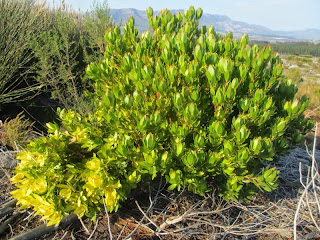Hello all,
I've loaded last week's walk on the blogspot www.sundayflowerwalks.blogspot.com
Spring? Well, it must be:
Almond trees on Compagnesdrift, alive with bees! The orchard rows are lined with these... Romulea tabularis?
We were keen to get back to the place where I found the pink flower among the mosses along the track. We picked out several of them, once we found the first and they certainly look like Drosera, or Sundews:
This one below looks as if it is pushing a flower up! The seed was quite firmly stuck in its grasp! One can see how poor the soil is, just coarse sand. The plant is said to catch insects and draws nutrients out of them instead of the soil.
Lobelia tomentosa still add spots of deep blue to the veld. According to the books, they shouldn't be in flower now, but they are!
A Gnidia, not sure which kind, with many clusters of buds at each stem end:
In this picture the leaves can be seen to be hairy. Many are described as hairless. The description that best fits it is G. ornata, but that's supposed only to be found east of Hermanus.
This looks like a pink Erica with a white one behind. But it's the white flowered plant which has had us guessing for a long time. The foliage looks like that of a Deodar Cedar.
The white flowers are tufts at the end of what looks like plaited green. What is it?
Some weeks ago I posted a picture of these bushes, mentioning that they looked slightly different as if one was male and one female. Well, this one has set berries:
... and this one has not, even though the remains of the flowers are still there:
We have seen this Struthiola before, it's difficult to miss now! We think it's S. ciliata.
At last! The first Wachendorfia paniculata bud! It will form a candelabra of yellow flowers.
This bokkie has been dead a long time, the dogs didn't even pick up a scent. Head bashed in :-(
I thought this might be two Leucadendron plants, m & f, but it's all one. Just the bottom left has set flowers.
Flower detail, L. laureolum?
At a casual glance this looked like yet another pink Erica, but is it?
These yellow Irises seem to flower and be over and done with without us catching them.
But this one has a bud, if we can find it again!
At last, buds on the Oftia or Teedia to help us distinguish which is which! If the flowers turn out mauve, then it's likely to be a Teedia lucida.
This looks like an Elegia persistens female. There appear to be seeds along all of the flowers.
Anina has kindly confirmed this is Elegia persistens and adds the following: "The little dark things under the golden spathes are actually the flowers. They are obscured by the dark brown bracts that enclose them, and the only hint you will see that they are flowering is when the anthers in the males or the styles in the females come popping out. The anthers are cup-shaped to hold the pollen until the wind disperses it. The styles of the female flowers are often feathery (to better catch the pollen) and can be quite dramatic in colour – cream, red or purple. Interestingly, there is quite high specificity in the pollen-style interaction – probably due to the shape of the pollen of an individual species and the corresponding style of the same species. One seldom sees the pollen of one species on the style of another, which is quite amazing as wind pollination is so random. For this reason restios do not hybridise."
Which is this Palmiet Tetraria?
Flower detail:
This grey-green bush is covered with white flowers.
On closer inspection, it looks as if they are spent as there are a few pink flowers left. Maybe we missed it this year?
The last bud on the Protea cynaroides; a laatlammertjie.
More Baroe Cyphia volubilis:
.... and a bud:
Good Night!
:-) A































Starting at the end that sunset, glorious. Now the plants, or the ones that catch my eye. Blossom on the Almond really does herald the coming of Spring as I watch Autumn slowly appearing round the corner. A pretty little Romulea, very striking flower and the Sundews? they are pretty common this side of the world in pots on kitchen window cills, real live fly catchers. Others I like, the white Cyphia, Struthiola and the pink Erica? Not into grasses, but the Gnidia almost looks like an ear of green unripe Barley. Nice photos again Andy.
ReplyDelete